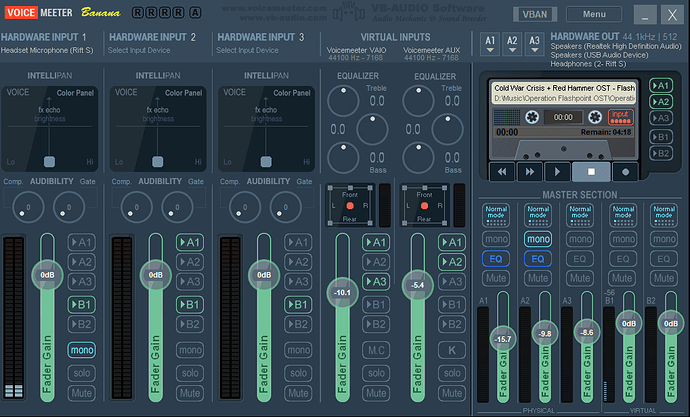Here is my audio setup. I have Voicemeeter Banana Virtual VAIO set as my primary audio device, which means all PC sounds come through that virtual input, then out to the physical devices, in this case A1 and A3. AUX is used as the dedicated audio device for SimShaker, and outputs to both sets of bass shakers, A1 and A2.
Summary
A1 is 4x Dayton TT25-16 bass shakers, connected in stereo configuration, and driven by two Nobsound 100W Amps. These amps are awesome, they’re very small but seem to put out more power than my Dayton DS70 (more on that in a minute), and never get hot. I’ve mounted one puck under each thigh of my seat, and one puck under each side console, directly under my throttle and sidestick. L/R channels drive two pucks each, giving me stereo that works very well.
A2 is 2x Dayton Audio BST-1, which are higher power transducers. One is mounted under the center of my seat bottom, and another at the lower back. I’m driving one with another 100W Nobsound Amp, but the other is driven by the Dayton DS70 amp, which was the first amp I bought.
(The DS70 is a huge panel-mount amp, but as large as it is it doesn’t put out near the power output that the cheaper, smaller Nobsounds do. Also, it gets very warm driving one 4 Ohm kicker, even though it’s rated for it. I would not recommend it, especially considering the price. Perhaps it’s the way I’m using it, as I’m pretty ignorant as far as audio goes.)
A3 is just my Rift-S headset, for audio output.
Eventually I want to figure out how to make SimShaker put out 5.1 sound, and separate A2 into Rear and Sub so that I get true ‘surround’ sound, but I’m not smart enough to figure out how to make that work, and haven’t found an ASIO driver that seems to do anything with my sound card, even though it has 5.1 output jacks and seems like I should be able to make it work. So for now, I drive A2 off of a USB sound card that was like $7 and seems to work well.
Under the Master Section, I’ve adjusted A1 & A2 levels so that they’re balanced okay, and set EQ to filter out anything but low bass, so that I can enable the VAIO input to also output to A1, and thus transform the bass in game sounds into tactile sensation. This means that in the Viggen Syria free flight, when the other Viggen stars up next to you, you feel his jet blast as it washes across your airplane until you get the canopy closed. It’s pretty cool. Also, if you pass closely at the merge, you can not only hear the other fighter, but also feel it as it goes by. The Viggen’s afterburner is incredible, as well as the thrust reverser, really makes the Viggen fun to fly! (Not that it wasn’t already, that is!)
Basically this just allows you to send effects to your shakers that SimShaker otherwise wouldn’t know to trigger or pick up. You feel more of the world around you.
The ‘problem’ lies in the fact that by doing so, your shakers are always putting out some level of effect. I had to adjust this so that it didn’t wash out the SimShaker effects too badly. Also, some effects overlap with simshaker (such as cannons firing), thus making them louder and sometimes messier feeling. So I turn it off (and then back on later) fairly regularly, depending on what I’m doing. This is also why I’m only outputting to one set of shakers, so that the effects from SimShaker still have a dedicated channel to output to and come through well-defined.
I need to make further adjustments to get to levels that I’m satisfied with. One thing I can do is turn the level of VAIO input down, and then turn A3 (headset volume) up, so that the game sounds don’t change but the signal going to A1 is lessened.
The tape player at the top right is how I test and balance the shakers, using a clip from the original Operation Flashpoint sound track that brings me right back to 2001, LOL!
Apologies in advance for the long winded droning post… Any advice from anyone that knows something about audio and has some further suggestions or tips for me is very much appreciated!
(Also, all credit to f4l0, who was where I got the original idea of using Voicemeeter in addition to just running Simshaker by itself.)
